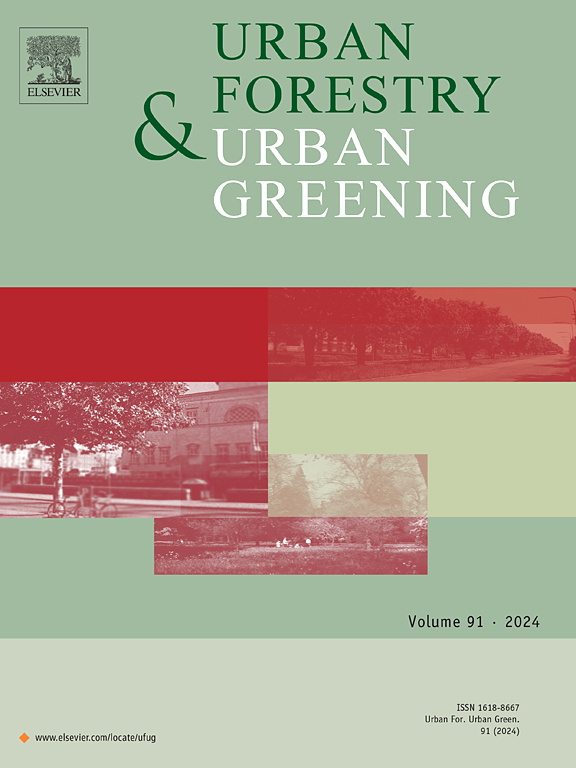Impact of the management of the lower level of urban greenery on water retention in urban ecosystems
IF 6
2区 环境科学与生态学
Q1 ENVIRONMENTAL STUDIES
引用次数: 0
Abstract
The different vegetation covers and management play an important role in improving soil water retention properties. The present research was carried out on the campus lawns of the University of Agriculture, Krakow, Poland, from May to October 2023, to examine the impact of vegetation covers and management, including mowed (A) and non-mowed lawns (B) or flower meadows (C) on soil water retention properties. The experimental plot size for each type of cover was 5 × 5 m2. Soil samples were collected monthly to measure water retention properties, such as current water storage capacity (Sa) and water storage capacity after 4 and 24 hours (S4 and S24). The volumetric water content (VWC (%)), soil water infiltration (seconds), soil temperature (ᵒC), air temperature (ᵒC), and humidity (%) were also measured. Parameters related to soil repellency and soil chemical properties, such as the percent nitrogen and carbon, were also determined. The Kruskal-Walli’s test revealed that the air temperature (ᵒC), soil temperature (ᵒC), volumetric water content (%), infiltration (seconds), nitrogen (%), and Sa (%) were statistically different among different vegetation covers A, B, and C. However, air humidity (%), S4 and S24, and carbon (%) were not statistically different in vegetation covers. The flower meadows recorded lower air temperatures (25 ᵒC) and soil temperatures (23 ᵒC), while the mowed lawn recorded higher air and soil temperatures (28 ᵒC and 27 ᵒC). The non-mowed lawn stored maximum VWC (14 %), and the flower meadow plot took the longest time (100 seconds) to infiltrate the water. The highest mean Sa, around 34 %, was observed in flower meadows and non-mowed lawns, while the lowest Sa was calculated in mowed lawns (25.2 %). It is concluded from the results that the establishment of flower meadows and non-mowed lawns should be encouraged in urban areas to conserve soil water, but mainly to reduce the heat island effect and improve the microclimate.
低水平城市绿化管理对城市生态系统保水的影响
不同植被覆盖和管理方式对改善土壤保水性能有重要作用。本研究于2023年5月至10月在波兰克拉科夫农业大学的校园草坪上进行,以研究植被覆盖和管理对土壤保水特性的影响,包括修剪过的(A)和未修剪过的草坪(B)或花草地(C)。每种覆被的试验小区面积为5 × 5 m2。每月采集土壤样品,测量其保水性能,如当前储水能力(Sa)和4和24 h后的储水能力(S4和S24)。测定了土壤体积含水量(VWC %)、土壤水分入渗(秒)、土壤温度(温湿度)、空气温度(温湿度)和湿度(%)。此外,还测定了与土壤驱避性和土壤化学性质有关的参数,如氮和碳的百分比。Kruskal-Walli’s试验表明,A、B、C三种植被覆盖间空气温度、土壤温度、体积含水量(%)、入渗(秒)、氮含量(%)、碳含量(%)差异具有统计学意义,而空气湿度(%)、S4、S24和碳含量(%)差异无统计学意义。花草甸的气温和土壤温度分别较低(25℃和23℃),而修剪过的草坪的气温和土壤温度分别较高(28℃和27℃)。未修剪草坪蓄水量最大(14 %),花草甸浸水时间最长(100 秒)。花草甸和未刈草甸平均Sa最高,约为34 %,刈草甸平均Sa最低,为25.2 %。结果表明,城市应鼓励建立花草甸和非刈割草地,以保持土壤水分,但主要是为了减少热岛效应和改善小气候。
本文章由计算机程序翻译,如有差异,请以英文原文为准。
求助全文
约1分钟内获得全文
求助全文
来源期刊

Urban Forestry & Urban Greening
FORESTRY-
CiteScore
11.70
自引率
12.50%
发文量
289
审稿时长
70 days
期刊介绍:
Urban Forestry and Urban Greening is a refereed, international journal aimed at presenting high-quality research with urban and peri-urban woody and non-woody vegetation and its use, planning, design, establishment and management as its main topics. Urban Forestry and Urban Greening concentrates on all tree-dominated (as joint together in the urban forest) as well as other green resources in and around urban areas, such as woodlands, public and private urban parks and gardens, urban nature areas, street tree and square plantations, botanical gardens and cemeteries.
The journal welcomes basic and applied research papers, as well as review papers and short communications. Contributions should focus on one or more of the following aspects:
-Form and functions of urban forests and other vegetation, including aspects of urban ecology.
-Policy-making, planning and design related to urban forests and other vegetation.
-Selection and establishment of tree resources and other vegetation for urban environments.
-Management of urban forests and other vegetation.
Original contributions of a high academic standard are invited from a wide range of disciplines and fields, including forestry, biology, horticulture, arboriculture, landscape ecology, pathology, soil science, hydrology, landscape architecture, landscape planning, urban planning and design, economics, sociology, environmental psychology, public health, and education.
 求助内容:
求助内容: 应助结果提醒方式:
应助结果提醒方式:


